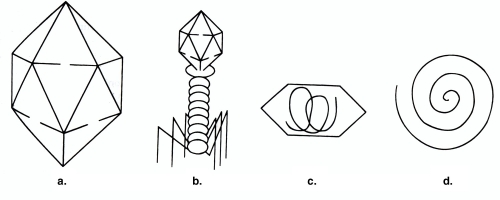Correct Answer

verified
Correct Answer
verified
Multiple Choice
Generally, in an infection caused by a DNA- containing virus, the host animal cell supplies all of the following EXCEPT
A) tRNA.
B) nucleotides.
C) RNA polymerase.
D) DNA polymerase.
E) None of the answers are correct; all of these are supplied by the host animal cell.
Correct Answer

verified
Correct Answer
verified
Multiple Choice
What contributes to antigenic shift in influenza viruses?
A) attachment spikes
B) different virus subtypes
C) a segmented genome
D) ease of virus transmission
E) worldwide distribution of the virus
Correct Answer

verified
Correct Answer
verified
True/False
Glycoprotein spikes are found on the capsids of all viruses.
Correct Answer

verified
Correct Answer
verified
Multiple Choice
The following steps occur during biosynthesis of a + strand RNA virus. What is the third step?
A) penetration and uncoating
B) synthesis of - strand RNA
C) synthesis of viral proteins
D) attachment
E) synthesis of + strand RNA
Correct Answer

verified
Correct Answer
verified
Multiple Choice
Which of the following statements provides the most significant support for the idea that viruses are nonliving chemicals?
A) They are chemically simple.
B) They are not composed of cells.
C) They cause diseases similar to those caused by chemicals.
D) They are filterable.
E) They cannot reproduce themselves outside a host.
Correct Answer

verified
Correct Answer
verified
Multiple Choice
How do all viruses differ from bacteria?
A) Viruses are not composed of cells.
B) Viruses do not have any nucleic acid.
C) Viruses are filterable.
D) Viruses do not reproduce.
E) Viruses are obligate intracellular parasites.
Correct Answer

verified
Correct Answer
verified
True/False
A segmented genome can result in antigenic shift.
Correct Answer

verified
Correct Answer
verified
Multiple Choice
Figure 13.1
 -The structures illustrated in Figure 13.1 are composed of
-The structures illustrated in Figure 13.1 are composed of
A) DNA.
B) Capsids.
C) RNA.
D) DNA or RNA.
E) Capsomeres.
Correct Answer

verified
Correct Answer
verified
Multiple Choice
Bacteriophages and animal viruses do NOT differ significantly in which one of the following steps?
A) uncoating
B) attachment
C) release
D) penetration
E) biosynthesis
Correct Answer

verified
Correct Answer
verified
True/False
Binomial nomenclature is used to name viruses.
Correct Answer

verified
Correct Answer
verified
Multiple Choice
An infectious protein is a
A) prion.
B) papovavirus.
C) retrovirus.
D) bacteriophage.
E) viroid.
Correct Answer

verified
Correct Answer
verified
Multiple Choice
Which of the following places these items in the correct order for DNA- virus replication? 1. Maturation 2) DNA synthesis 3) Transcription 4) Translation
A) 1; 2; 3; 4
B) 3; 4; 1; 2
C) 2; 3; 4; 1
D) 4; 1; 2; 3
E) 4; 3; 2; 1
Correct Answer

verified
Correct Answer
verified
Multiple Choice
A virus's ability to infect an animal cell depends primarily upon the
A) host cell's ability to phagocytize viral particles.
B) type of viral nucleic acid.
C) enzymatic activity of a host cell.
D) presence of receptor sites on the cell membrane.
E) presence of pili on the host cell wall.
Correct Answer

verified
Correct Answer
verified
Multiple Choice
The following steps occur during multiplication of retroviruses. Which is the fourth step?
A) penetration
B) uncoating
C) synthesis of double- stranded DNA
D) attachment
E) synthesis of +RNA
Correct Answer

verified
Correct Answer
verified
Showing 41 - 55 of 55
Related Exams